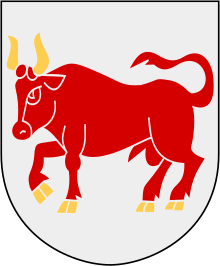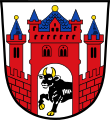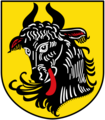Bull (heraldic animal)

The bull , ox , buffalo or cow is a heraldic animal belonging to the heraldic figures . Coats of arms with a bull's head are also called a bull's head shield .
Bull head
The bull's head can appear alone in the coat of arms. If the head is shown with the torn neck fur attached, the torn neck fur must be emblazoned . The heraldic element head is often found on Mecklenburg and Silesian coats of arms. The Swiss canton of Uri also has the bull's head (called Uristier ) in its coat of arms.
Austrian Crown land of Bukovina (1867)
Coat of arms of the second Republic of Moldova (1991)
Bull and cow
He is shown walking , climbing or erect . He is said to be a "shaggy and wild, huntable buffalo bull".
The female cow is also often taken into account in heraldry. In the coat of arms, the cow usually has its tail between its legs; the coat of arms of Andorra differs from this representation. Bulls, oxen and buffalo usually have raised or thrown back tails; repulsed means that it points over the back of the animal towards the head. Aurochs (primal) and bull are often not differentiated - overall, the blazon (i.e. the meaning of the coat of arms) is decisive, not the specific representation.
Duchy of Mecklenburg : bull heads in the first and sixth field, for Mecklenburg and Werle, on the right a bull as a shield holder
- Striding black bull in the coat of arms of the ancient Mecklenburg knight dynasty von Plesse (n) , 13th century
Azores : two upright black bulls hold the flag of the Order of Christ and the flag with the flying dove of the Holy Spirit with their lances as shield holders
Coat of arms of the province of Béarn
Niederlausitz full coat of arms
Coat of arms of Ochsenfurt
Coat of arms of Vils in Tirol
The red ox is the heraldic animal of the Niederlausitz / Dolna Łužyca and its capital Luckau , the Niederlausitz Society for History and Regional Studies also has the animal in the club logo. Since the bull occurs both here and in the coat of arms of Mecklenburg , it can be assumed that it is a Slavic context. (The ruling dynasty of Mecklenburg was always derived from the Elbe Slavic Obodrites , Niederlausitz / Dolna Łužyca is still Slavic (Wendish / Sorbian) today.) Various place names in the region are also derived from the (Auer) ox, the corresponding Sorbian word "tuŕ" can be found in Tauer / Turjej or Turnow . The legend behind the red ox as the heraldic animal of Lower Lusatia is as follows: One day the devil wanted to plow with his red ox (elsewhere there is talk of a Polish ox). The ox was not very willing and the devil was irascible, so he began to abuse and beat the ox. Then the animal broke loose and ran across country. Since he was still pulling the plow behind him, many deep furrows were created all over the place. These filled with water and the beautiful Spreewald / Błota was created. As a reminder, the ox is now the heraldic animal of the region. In Osterholz-Scharmbeck there is a tethered bull for the local cattle market.
There is also an ox's head in the coat of arms of the Schleswig-Holstein municipality of Kropp to symbolize the nearby ox path. Other examples are the Dahme-Spreewald district or Oxford in the UK . Here, as in Oss / NL , the coat of arms is meaningful , because the latter city name translates as ox .
Winged bull
A special feature is the winged bull . Here the bull has wings attached at shoulder height. the winged bull is the sacred attribute of the Evangelist Luke .
In the Achaemenid period (559–330 BC) of Persian art, the Assyrian royal palaces served as models for decorating the walls and stairs in limestone . Relief depictions of the king and his companions, as well as tribute-offering peoples or the battles with mythical creatures, furthermore the winged bulls with human heads at the gateway of Xerxes I and mosaics made of enamelled bricks in Susa prove this.
growing nimbated winged bull with golden clover stems in the wings ( Dolní Heřmanice )
A bull lying on the Gospel of Luke in the coat of arms of the Croatian community Škabrnja
literature
- Cattle (Heraldry) in the Heraldry Wiki
Web links
Individual evidence
- ↑ see for example: About the predella in the altar of the castle chapel . Blutenburg (castle and chapel), with the four evangelists.
- ^ Author collective: Brockhaus' Konversationslexikon. Volume 12, FA Brockhaus, Leipzig / Berlin / Vienna, 1894–1896, p. 1040.















